Name España Commissioned 23 October 1913 Launched 5 February 1912 | Laid down 6 December 1909 Construction started 6 December 1909 Length 140 m | |
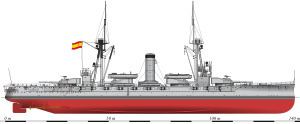 | ||
España was a Spanish dreadnought battleship, the lead ship of her class. She had two sister ships, Alfonso XIII and Jaime I. España was built by the SECN shipyard; she was laid down in December 1909, launched in February 1912, and completed in October 1913. She was armed with a main battery of eight 305 mm (12.0 in) guns and had a top speed of 19.5 knots (36.1 km/h; 22.4 mph)
Contents
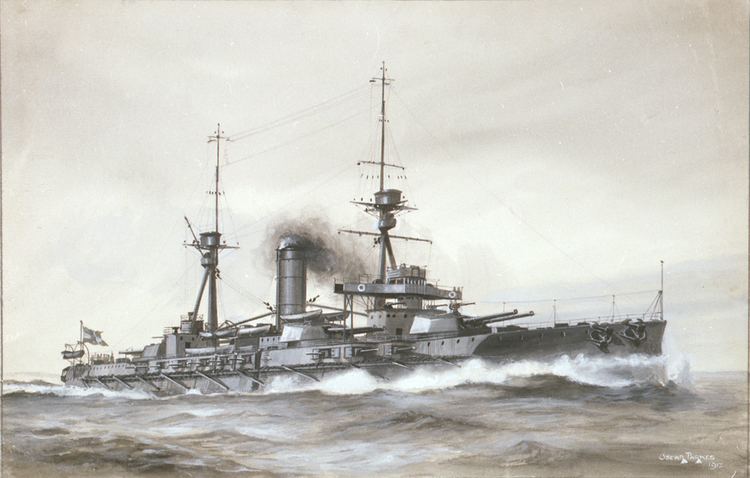
España served in the 1st Squadron after her commissioning, along with her two sisters. Spain remained neutral during World War I, so the Spanish fleet did not see action during the conflict. España provided gunfire support during the Rif War in the early 1920s. During these operations, she ran aground off Cape Tres Forcas, Morocco in August 1923. The Navy was unable to raise the ship, and severe storms destroyed the wreck in 1924, which led the Navy to abandon her.
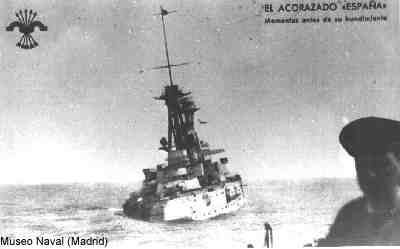
Technical characteristics
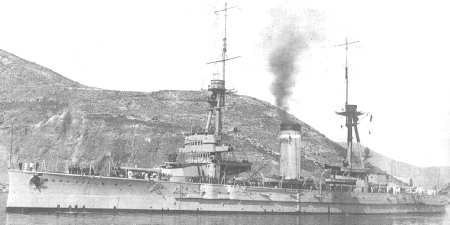
España was 132.6 m (435 ft) long at the waterline and 140 m (460 ft) long overall. She had a beam of 24 m (79 ft) and a draft of 7.8 m (26 ft); her freeboard was 15 ft (4.6 m) amidships. Her propulsion system consisted of four-shaft Parsons steam turbines and twelve Yarrow boilers. The engines were rated at 15,500 shaft horsepower (11,600 kW) and produced a top speed of 19.5 knots (36.1 km/h; 22.4 mph). España had a cruising radius of 5,000 nautical miles (9,300 km; 5,800 mi) at a speed of 10 knots (19 km/h; 12 mph). Her crew consisted of 854 officers and enlisted men.

España was armed with a main battery of eight 305 mm (12.0 in) /50 guns, mounted in four twin gun turrets. One turret was placed forward, two were positioned en echelon amidships, and the fourth was aft of the superstructure. This mounting scheme was chosen in preference to superimposed turrets, as was done in the South Carolinas, to save weight and cost. Her secondary battery consisted of twenty 102 mm (4.0 in) guns mounted in casemates along the length of the hull. They were too close to the waterline, however, which made them unusable in heavy seas. She was also armed with four 3-pounder guns and two machine guns. Her armored belt was 203 mm (8.0 in) thick amidships; the main battery turrets were protected with the same amount of armor plate. The conning tower had 254 mm (10.0 in) thick sides. Her armored deck was 38 mm (1.5 in) thick.
Service history

The Navy Law of 7 January 1908 authorized construction of España. She was laid down at the Sociedad Española de Construcción Naval shipyard in Ferrol on 6 December 1909. She was launched on 5 February 1912, and completed on 23 October 1913. After their completion, España and her sisters, Alfonso XIII and Jaime I, the three battleships formed the 1st Squadron of the Spanish fleet. Spain remained neutral after the outbreak of World War I in August 1914, so España and her sisters were the only European dreadnoughts to avoid the war. In mid-1915, España crossed the Atlantic to represent Spain at the opening ceremonies for the Panama Canal. Since the major European navies were occupied with World War I, only Spain and Portugal sent ships to the ceremonies.
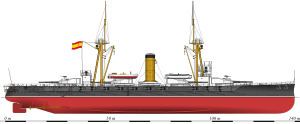
In 1920 España carried the Spanish representative to the quatercentenary of the discovery of the Straits of Magellan in Chile, in the process becoming the Spanish Navy's first ship to pass through the Panama Canal. On 29 January 1921 she ran aground in Chilean waters off Puerto Montt on her return to Spain, though she was refloated with some difficulty. Her hull was dented badly for a length of 150 ft (46 m), and the rocks tore a large hole that was approximately 8 by 8 ft (2.4 by 2.4 m) between frames 22 and 36, and several smaller holes between frames 48 to 56 on the port side and 58 to 76 on the starboard side. Divers effected temporary repairs with concrete in Chile, followed by permanent repairs that were made in Balboa, Panama before she made her return voyage across the Atlantic. During this period, she was assigned to the Training Squadron, along with her two sister ships. Throughout the early 1920s, she provided fire support to the Spanish Army in its campaigns in Morocco during the Rif War. While conducting a bombardment off Cape Tres Forcas near Melilla on 26 August 1923, she ran hard aground.
The Spanish Navy hired two salvage companies to refloat the battleship, but both declined after they surveyed the wreck. Unable to raise her, the Spanish decided to remove as much weight as possible from España in an attempt to lighten her to permit refloating. Her guns were removed and dropped overboard to be picked up later by the salvage vessel Kanguro. The battleship's armor, machinery, and ammunition stores were also removed to lighten her. Her hull was then sealed and partially drained in preparation for raising, but while waiting for the necessary equipment from Italy, several violent storms hit the ship and caused further damage. The battered hull could now no longer be raised, and in November 1924, she broke in half and was abandoned by the Spanish Navy. The 305 mm and 102 mm guns recovered from España were installed in coastal batteries, some of which remained in service until 1999 before they were retired from service. After the overthrow of King Alfonso XIII, his namesake ship Alfonso XIII, was renamed España in April 1931.
